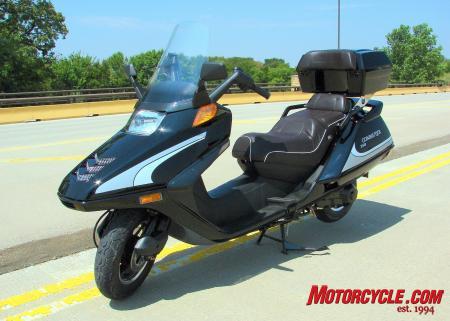2008 QLINK Commuter 250 Review - Motorcycle.com
Get the Flash Player to see this player.
Many of these scooters looked alike but had different brand names attached to them. Sometimes they were actually the same scooter rebranded and supported by different distributers and other times they are a clone of a clone made with lesser components and supported by no one. The latter are usually the scooters you see online at some ‘super x-treme scooter clearance warehouse’ and they normally transport the owner one mile for every dollar spent before they are ready for the scrap yard. They sell like hotcakes and as long as they have customers they will continue to press them out.
As far as clones go, I expected a Chinese clone of a Honda scooter to turn out like the 2-wheeled equivalent of Michael Keaton as ‘Four’ in Multiplicity. Was I disappointed? Not at all. Whose idea was it to attempt to fill the shoes of one of the biggest names in powersports? My first scooter was a 1985 Honda Helix and THIS, my friend, was no Honda Helix. These were the thoughts that went through my head when I first took the QLINK Commuter 250 out of the garage. What was that squeaking sound? It has speakers, but only one worked. I adjust the mirrors and they pop back into their original place. The look was definitely Honda, circa 1985, but the fit and finish was undoubtedly Chinese 2005.
I decided to start over. I took a deep breath, “Steve, this isn’t the time to be a scooter snob.” I told myself. Look at this for what it is, an affordable commuter scooter. Does it start? Does it move? Does it stop? Is it roadworthy? Those are the important questions. Setting my expectations aside, I swore to give this scooter a fair test.
Did it start? Every time. The slightest press of the ignition button cranked her right up. Good. Did it move? Well, under the seat was a 244 cc, 18 hp engine (a clone of the original Honda engine) and it did alright. I could tell the throttle and/or carburetor needed an adjustment. Twisting to 95% throttle brought her up to 55 mph and giving her the extra 5% brought her back down to 52 mph. See what I mean? To be fair, this scooter was as green as they get. By that, I mean it only had 1 mile on the odometer when I took her out of the warehouse. You’re not going to reach a scooter’s top speed potential if it hasn’t yet been broken in.
Was she road worthy? Sure. The Commuter 250 felt well balanced just like my old Helix. The suspension was fine and the wheels held fast to the pavement. Steering was solid and the ride was about as smooth as my old Helix. So, what do you get for your money?
The Package
Let’s look at what you get for the $3,349 (MSRP) price tag. First, take a long and low scooter built in the tradition of the very successful Honda Helix, which Honda stopped producing in 2007 after 22 years with hardly a change (Honda truly lives by the “if it ain’t broke, don’t fix it” motto.) Then add a flashy (literally) spoiler and a HUGE top case and throw in a pair of speakers and an FM/USB thumb drive MP3 music player then you’d almost have the Commuter 250.
Now add a two-year factory warranty, one year of roadside assistance and the dealer support of QLINK. At this point you’ve got a product that separates itself from your standard ‘disposable’ Chinese scooter. When you’ve got a dealer network to fix the issues and a distributor that can get them the parts, the owner experience really improves. “See Steve?” I thought to myself, “The picture doesn’t look quite as bleak as it seemed at first.” If your budget is tight and you’re are looking for an affordable commuter that resembles a Honda Helix, but costs $2,000 less, then you might have a winner in the Commuter 250. I’ve heard from owners that get 70 mph and between 60 and 70 mpg out of their Commuter 250’s and they are perfectly happy with them.
The Impression
As I considered the Commuter 250 as a whole, I saw what was going on. Minus the need for a few adjustments and about 200 more break-in miles, the major components functioned fine. It was the small, nit-picky things that gave the Commuter 250 such a bad rap. You don’t hear those squeaks on a Japanese scooter. They don’t have a problem with only one speaker working (they don’t have speakers). There was a rat’s nest of wires in the glove box where the MP3 player and fuse cluster were added. You won’t see that in a Japanese scooter, because they don’t have MP3 players.
I took the Commuter 250 back to the garage and began pointing out the little things that were bugging me. The in-house technician said “ok, let me see.” and he jumped on her with a Philips-head screwdriver in hand and pulled off the dashboard. He traced the speaker wire to a connector, flipped the plug and BINGO, speaker two began working. “Hmm… that was easy. How about these mirrors that won’t stay in place?” He took the screw driver to it and Ta-dah, they stayed firmly in place. There’s the pattern I was talking about. The thing about these Chinese scooters is that they work, they just need adjustments. If you’re mechanically inclined you could easily poke and prod the Commuter 250 until you’ve got all the little gremlins worked out. Luckily, with a two-year warranty, you could just go back to your dealer until THEY work out all the gremlins. If I could offer some advice to QLINK dealers, I’d say, have your technician spend an hour squashing the bugs before you put the scooter on the floor and just add the time to the ‘dealer prep’ line on the invoice. Your customer will be thankful for it.
The Conclusion
After I gave the Commuter 250 a fair-shake, I can safely say that she’s still no Honda Helix. A Japanese scooter has flawless fit and finish. Everything about them is neat and tidy. If that is worth the extra $2,000 (above the $3,349 MSRP) to you, then you’d better stick with the original. We didn’t have three years to do a long term test, so we don’t know if the Commuter 250 will be still be on the road after 60,000+ miles, as is common for a Honda Helix, but if it is we’ll be mighty impressed.
If you are looking for a new scooter that comes stock with greater storage capacity than the Helix, more bells and whistles (FM Radio and MP3 player with speakers, flashing spoiler / brake light), has a longer warranty and roadside assistance then you might think about giving the Commuter a shot. I talk to many dealers and hear lots of good things about QLINK’s support and parts availability. What does that mean for you, the cost conscious shopper? QLINK’s Commuter 250 can offer you a good value with fewer headaches.
Bike Personality Profile - If this machine could have its own personality, summed up in one or two words, what would it be?
The QLINK Commuter 250 is a parsimonious machine.
TheScooterScoop.com is your dedicated source for scooter and microcar news, reviews, commentary and the celebration of wheeled oddities.
More by Steve Guzman

































Comments
Join the conversation